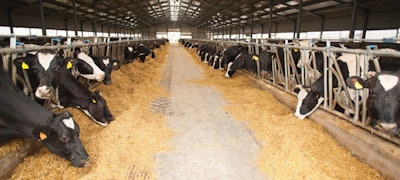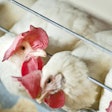
The right strains of yeast will provide a natural gut flora stabilizer in cows.
Yeasts reproduce by budding or fission resulting in growth by groups of single cells. The most well-researched, Saccharomyces cerevisiae, has many diverse functions in both human and animal diets. Many different strains of this yeast exist, and all vary slightly with regards to their effects on the animal.
Ruminants have evolved to make use of low-quality, fibrous feed material via microbial fermentation in the reticulo-rumen. This microbial ecosystem generates sources of energy, nitrogen and other nutrients via the breakdown of dietary ingredients. Volatile fatty acids (VFA) are the end-product of bacterial fermentation of carbohydrates and are absorbed across the rumen wall as the primary energy source for the ruminant.
Diets high in soluble carbohydrates (starch and sugar) can lead to over-production of VFA, particularly propionate and lactate and, ultimately, a drop in rumen pH, sub-acute acidosis (SARA) and/or acute acidosis. Cellulolytic bacteria are active within a narrow pH range (above 6.0) and can only survive for a relatively short time below this range before their growth and activity are compromised and fiber digestion is inhibited.
Yeast in ruminant diets
Interest in yeast as part of ruminant diets has been cited as far back as 1925, but its mode of action was not fully understood. Over the last three decades, in-depth investigation has revealed that the main effects of yeast relate to alteration in microbial fermentation in the rumen. Primarily, yeast, or rather S. cerevisiae, stimulates the activity of cellulolytic bacteria, those that utilize lactate (particularly S. ruminatium) as well as total anaerobic bacteria, helping to reduce the amount of time the rumen pH falls below 5.5.
Most beneficial bacteria in the rumen rely on a stable, anaerobic environment to function. S cerevisiae is known to scavenge (respire) oxygen entering the rumen on feed particles, helping to promote an anaerobic environment and promoting anaerobic bacterial growth. Additionally, stimulatory co-factors are thought to be involved in increasing bacterial growth meaning that live yeast is likely to be more effective compared with “dead” or inactivated yeast.
Benefits of yeast in dairy cows
Numerous beneficial effects have been reported for the inclusion of yeast in ruminant diets. However, the response of animals to yeast inclusion is influenced by several factors, including diet, days in milk and yeast strain.
Yeast is documented to stabilize the rumen environment with effects including higher rumen pH, increased numbers of cellulolytic bacteria and reduced lactate concentration. Although no effect on rumen pH or cellulolytic bacteria, one study found the addition of yeast reduced peak rumen lactate concentration two to three hours post-feeding in fistulated dairy cows. Researchers also found a lower rumen ammonia concentration following yeast inclusion, which, they hypothesized, resulted from greater incorporation of nitrogen into microbial protein. However, a different study also put forward the idea of reduced proteolysis in the rumen.
Dairy heifers also picked up reductions in rumen ammonia nitrogen concentration. Dairy heifers supplemented with live yeast culture exhibited increased VFA production and a possible stimulation of nitrogen uptake by rumen bacteria. Researchers have noted an increase in average rumen pH across time in dairy cows when yeast has been added to the diet. These authors used a pH meter resident in the rumen across periods of two weeks and state that a beneficial effect of yeast could potentially be early as one week after supplementation. Yeast increased propionate production but elicited only a modest effect on biological efficiency.
Yeast in calf, bull diets
Moving away from dairy cows, a significant improvement in rumen parameters in buffalo calves fed a high forage diet. Rumen pH and cellulolytic bacterial count were increased, and rumen ammonia nitrogen decreased relative to control animals. Again, beneficial effects were seen after only one week of supplementation. It is interesting to note that these positive effects were seen on a high-forage diet when other studies highlight a greater response in more starch- or concentrate-based diets.
In a study investigating the effect of yeast on bulls fed a barley beef diet, both total VFA and acetate production was increased without any effect on propionate or acetate:propionate ratio. This, together with the improved DMI, suggests an increase in fermentation rather than a shift in fermentation patterns. Similarly, there was a reduction in lactate concentration together with a concomitant increase in pH when yeast was added to the diet of steers.
In a linked experiment, they also noted increased DMI and subsequent milk yield in Friesian dairy cows, whereby yeast effects were more noticeable at higher levels of concentrate in the diet, supporting evidence for dietary influence over yeast effects. Overall, most yeasts are accepted as gut flora stabilizers.
 Yeast can improve rumen fermentation by decreasing lactate, which reduces the risk of acidosis. (Costa007 | Dreamstime.com)
Yeast can improve rumen fermentation by decreasing lactate, which reduces the risk of acidosis. (Costa007 | Dreamstime.com)Effect on milk production
Increases in milk production have often been numerical rather than statistical. One study demonstrated a 5.8% numerical increase in milk yield and yet another trial from a different study noted a 6% non-significant increase. Additionally, another saw a non-significant increase in milk yield of 0.6 kg/d. Milk composition has been shown to be affected by yeast supplementation. Significant increases in milk fat and/or milk protein have been demonstrated in several dairy studies, as well as numerical increases.
Benefits appear to be more obvious during early lactation when negative energy balance (NEB) is an issue. Yeast supplementation has little effect in early lactation Holstein Friesians on milk performance parameters, including milk yield and composition, as well as dry matter intake (DMI). Despite this, there was a numerical increase in milk yield, which would have been of importance from a financial aspect commercially. In one meta-analysis, it was found a 1.2g/kg BW increase in milk yield and a 0.05% increase in milk fat.
Performance in terms of product output is not the only potential use for yeast cultures. Although no effect on NEB in dairy cows post-partum, yeast supplementation improved serum insulin, the peak in oestradiol prior to ovulation and the size of the first ovulatory follicle post-partum. Researchers suggest further investigation into these effects. When evaluating the effect of an enzymatically hydrolyzed yeast on immunity in transition cows, researchers noted an improved humoral immunity together with a modulatory effect on uterine and mammary gland health.
While response to yeast appears varied and inconsistent in the literature, overall there are trends of improvement along the lines described above. However, not all yeasts are the same and not all commercially available products are comparable “gram for gram.” Commercially, there are numerous yeast products available for use in ruminant livestock and other species. All are based on different strains. Probably, the major distinction between them is whether the yeast is alive or dead.
Summary
In conclusion, yeast cultures of S. cerevisiae have been used both commercially and experimentally in ruminant diets for several decades. There are many different strains, all of which differ in their effects in the animal and minimum effective dose. The likely mode of action is concerned with oxygen scavenging to promote an anaerobic, more stable environment for ruminal bacteria. However, it is also likely that stimulatory compounds are generated by the activity of the yeast.
Key effects appear to be an improvement in rumen fermentation with a decrease in lactate, reducing the risk of acidosis. Improved DMI has been related to improved performance, albeit numerical, in many studies. Though care needs to be taken when interpreting results from different strains of yeast, the use of yeast in ruminant diets has its place as a natural gut flora stabilizer.
References available on request.













